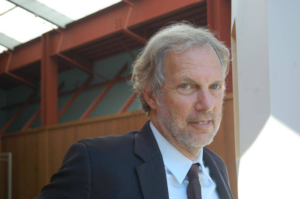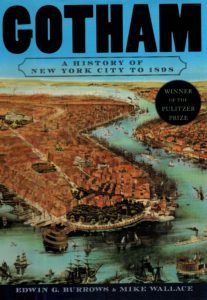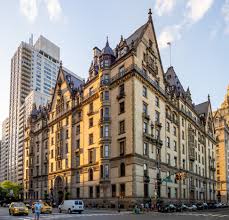The Initiative For Fair Open Access Publishing In South Asian Studies ~ The 2020 Manifesto
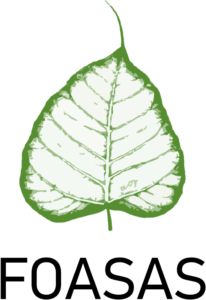 The 2020 Manifesto for Fair Open Access Publishing in South Asian Studies
The 2020 Manifesto for Fair Open Access Publishing in South Asian Studies
Profiteering and restricted access have led to a crisis in academic publishing. The Fair Open Access movement is best promoted by mobilizing individual disciplines. With this manifesto, we, an open group of scholars of classical and modern South Asian Studies, declare our support for Fair Open Access publishing.
§1 As is well known, the impact of publications is very often contingent on factors independent of the quality of the research or the competence of the authors. This includes that the research is published in a renowned journal (or other publication medium), by a renowned editor, or – and this has become a major problem – by a prestigious publishing house.
§2 Most of the prestigious publication media are nowadays controlled by a small number of profiteering international publishers. These companies often sell their products at unjustifiably high prices. Much of the editorial work, on the other hand, is outsourced to researchers (or their co-workers, assistants, employees, secretaries etc.). Because they depend on the prestige capitalized on by the publishers, they generally do this without payment. This situation has led to a real crisis in academic publishing.
§3 The Open Access (OA) movement is a reaction to this development: the advance of digitization has made it easy to make the results of research freely available on the internet. OA publishing offers free access to research, regardless of an individual’s financial means or affiliation with a subscribing institution. In the OA model, the individual reader does not pay (except, of course, in the case of printed works). Instead, the publication costs are borne by universities, libraries, scholarly societies, professional associations or other scholarly institutions. While in the wake of this development a number of institutions have founded in-house publishing projects, some commercial publishers have started to offer OA as well.
§4 In order to compensate for the revenue losses resulting from the free availability of OA publications, however, some profiteering publishers have begun to calculate special fees – imposed on the authors or their institutions. Most often, these fees are unjustifiably high and overcompensate for the production costs. As a growing number of academic institutions nowadays demand that the publications of their employees be OA, they are willing to pay these fees. They even regularly schedule a special budget to finance the publishers.
§5 Ultimately, however, it is the tax payers who have to pay, often several times: funding for research and researchers, library budgets for subscription fees, acquisition of overpriced books, processing costs charged by the publishers for OA publications etc. The only reason this system functions is that researchers and their institutions are dependent on the prestige that profiteering publishers have capitalized on for commercial benefit.
Go to (incl. List of Publishers & Journals): https://foasas.org
It’s Time To Nationalize The Fossil Fuel Industry
The COVID-19 pandemic’s impact on the economy provides a golden opportunity for creating a fairer, more just and sustainable world as it shatters long-held assumptions about the economic and political order. Its impact on the energy industry in particular can boost support for tackling the existential threat of global warming by raising the prospect of nationalizing and eventually dismantling fossil fuel producing companies, a position argued passionately by one of the world’s leading progressive economists, Robert Pollin, distinguished professor of economics and co-director of the Political Economy Research Institute at the University of Massachusetts at Amherst.
C.J. Polychroniou: It has been argued by many that the coronavirus pandemic is a game changer for numerous industries, and could change the way we work and the way we use energy. We could also see the possible return of the social state and thus the end of austerity. First of all, are there any comparisons to be made between the current health and economic crises and what took place during the Great Depression?
Robert Pollin: There is one big similarity between the economic collapse today and the 1930s Great Depression. That is the severity of the downturns in both cases. The official U.S. unemployment rate coming from the Labor Department as of May 2020 was 13.3 percent. But a more accurate measure of the collapsing job market is the number of workers who have applied for unemployment insurance since the lockdown began in mid-March. That figure is 44 million people, equal to about 27 percent of everyone in the current U.S. labor market, employed or unemployed. By contrast, during the Great Recession of 2007-09, official unemployment peaked, and for one month only, at 10.0 percent.
However, between 1930 and 1939, U.S. unemployment averaged about 18 percent, peaking at nearly 25 percent in 1933. The obvious difference between the 1930s and now is that the 1930s figure is an average over 10 brutal years. Our current severe job market is not going to last for 10 years. It could only last for a few more months, before the official unemployment rate gets to something like the more “benign” levels of Great Recession years, i.e. “only” 8-9 percent. Still, since the March lockdown, the severity of the unemployment crisis has been comparable to the 1930s.
This brings up the single most critical point of contrast between the 1930s and today. That is, we could have easily seen a decade-long economic depression now, except for the fact that the federal government today has intervened to an unprecedented extent to counteract the depression, while in the 1930s, the government did not intervene at the necessary scale until World War II.
The list of ways in which orthodox economists and government policymakers today are clueless is very long indeed. But they have at least figured out that, to stave off a 1930s-level depression, you pump massive amounts of money into the economy. For now, this has thus far included the so-called CARES Act, which passed Congress and Trump signed in March. This was a $2 trillion injection, equal to about 10 percent of the overall U.S. economy (Gross Domestic Product, or GDP), and still more important, Federal Reserve bailout funds for big corporations and Wall Street, to the tune of something like $5 trillion — 25 percent of GDP — and counting. Without the CARES Act and Federal Reserve bailouts, we could easily be looking right now at a replay of the 1930s. Things are bad enough as it is, of course. Plus, it is clear that the federal government funds are largely being stuffed into the pockets of corporations instead of where they are needed. Spending on public health — in the midst of a pandemic no less — as well as public education, and direct support for workers and the poor are getting short shrift, as usual.
The oil and gas industry has been particularly hard hit during the coronavirus pandemic. In that context, some, including yourself, have argued quite passionately that the time is ripe for nationalizing the fossil fuel industry. What would be the advantages of doing so? And how could we finance the transition to a sustainable energy future?
The underlying issue here is that, according to the thoroughly mainstream and highly cautious projection of the Intergovernmental Panel on Climate Change (IPCC) we, the residents of planet Earth, have 30 years total to achieve net zero carbon dioxide (CO2) emissions to have a reasonable chance of avoiding the most severe impacts of climate change — in terms of heat extremes, heavy precipitation, droughts, floods, sea-level rise and biodiversity, and the corresponding impacts on health, livelihoods, food security, water supply and human security. There is no avoiding what this means — which is that the global fossil fuel industry simply must be put out of business within the next 30 years. This is for the simple reason that burning fossil fuels to produce energy is what spews CO2 into the atmosphere, and is therefore the primary cause of climate change. The need to put an end to the fossil fuel industry remains an imperative, regardless of whether the industry is facing financial difficulties, as they are at present, or swimming in profits. Everyone on the planet simply has to stop burning oil, coal and natural gas to produce energy. We can, of course, take it as a given that the fossil fuel companies will fight fiercely, using every single tool at their disposal, to keep themselves alive, so that they can continue to reap big profits from destroying the Earth.
Nagekomen post
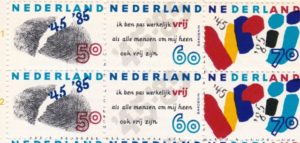 In 1984 vroeg de PTT kunstenaar Jan Bons een aantal postzegels te ontwerpen voor de veertigjarige herdenking van de Bevrijding in 1985. Voor zijn 60-cent zegel wilde hij een uitspraak van een van de aartsvaders van het anarchisme, Michael Bakoenin gebruiken: ‘Ik ben pas werkelijk vrij als alle mensen om mij heen ook vrij zijn’.
In 1984 vroeg de PTT kunstenaar Jan Bons een aantal postzegels te ontwerpen voor de veertigjarige herdenking van de Bevrijding in 1985. Voor zijn 60-cent zegel wilde hij een uitspraak van een van de aartsvaders van het anarchisme, Michael Bakoenin gebruiken: ‘Ik ben pas werkelijk vrij als alle mensen om mij heen ook vrij zijn’.
De PTT wees het ontwerp af. Anarchisten op postzegels, het is geen voor de hand liggende combinatie. De uitgifte van postzegels is immers van oudsher een staatsaangelegenheid en anarchisten zijn tegenstanders van iedere staatsvorm. Helemaal wereldvreemd is het verschijnsel toch niet.
Jan Bons had voor zijn ontwerp nog wel advies gevraagd aan historicus en Bakoenin-deskundige Arthur Lehning over de juistheid van de uitspraak. De beoordelingscommissie van de PTT had echter alleen maar negatief commentaar op de zegels van Bons, ook op het feit dat een uitspraak van een anarchist was gebruikt. Na veel geharrewar en nieuwe ontwerpen die opnieuw werden afgewezen, was Bons het zat en gaf hij de opdracht terug. Een velletje van de door Bons ontworpen zegels verscheen later als bijlage in een brochure over de affaire.
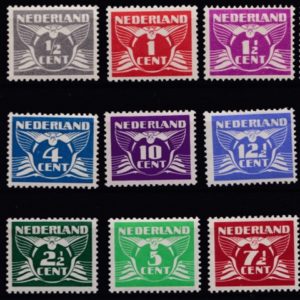 Vredesduif
Vredesduif
Op Nederlandse postzegels zijn geen anarchisten afgebeeld. Wel ontwierp kunstenaar Chris Lebeau (1878-1945), overtuigd anarchist, in de jaren dertig een telkens herdrukte reeks zegels die ook meerdere malen werd uitgebreid. Op een gekleurde ondergrond plaatste hij een witte vredesduif, met het aangezicht naar de kijker, op het buikje van de duif oplopende frankeringen: een halve cent, één cent, anderhalve cent, twee cent etc. Ook ontwierp hij nog enkele luchtpostzegels. Hij weigerde echter zegels met de koningin te ontwerpen. Lebeau ontwierp batikdoeken, tafelkleden, lampen, glas-in-loodramen, maar ook tapijten, glaswerk en affiches in art-decostijl. Tijdens de oorlog vervalste hij persoonsbewijzen. Hij stierf in het concentratiekamp Dachau. Wrang is dat tijdens de oorlog de bezetter, bij gebrek aan nieuwe postzegels, reeds gedrukte vellen van Lebeau’s zegels, overdrukte met een hakenkruis over de vredesduif. Deze zegels zijn echter nooit in omloop gebracht.
Partijleiders
De meest voorkomende figuur op postzegels is het staatshoofd, of deze nu gekozen is, of via erfopvolging, of dictatoriale weg op die plek terecht is gekomen. Op zegels van dictatoriaal geregeerde landen zijn veelal heroïsche gebeurtenissen uit de geschiedenis van het land afgebeeld. Zegels van het Libië onder Gadaffi en van het Korea van de familie Kim zijn daar sprekende voorbeelden van. Dit soort zegels zijn vooral een vorm van propaganda voor het regiem.
Ook in het vroegere communistische Oostblok was dat het geval, zoals in de DDR. Daar verschenen in de jaren vijftig en zestig veel zegels met Marx, Engels en Lenin en werden partijleiders Wilhelm Pieck en Walter Ulbricht vaak prominent geportretteerd. Onder de leiding van Erich Honecker verminderde echter het aantal zegels met Marx, Engels en Lenin.
Partijleiders verschenen ook steeds minder vaak op zegels. In die jaren verschoof het beeld naar bloemen, vogels en vlinders, industriële producten en telkens weer de Olympische Spelen, waar het land natuurlijk hoge ogen probeerde te gooien.
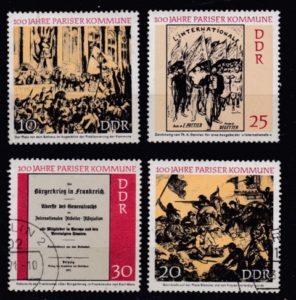 Volksopstand
Volksopstand
De DDR eigende zich op zegels historische personen en gebeurtenissen toe, hoewel die op zich geen verbintenis hadden met het land. Reeds overleden wetenschappers, kunstenaars, schrijvers en filosofen werden zonder probleem ingelijfd in de DDR-ideologie.
Communistische verzetsstrijders uit de nazitijd waren tijdens de Koude Oorlog een geliefd onderwerp op postzegels, bij voorkeur wanneer deze geboren waren of geleefd hadden op het toekomstige grondgebied van de DDR. Maar blijkbaar was dat niet altijd nodig want ook verzetstrijdster Hannie Schaft werd door de DDR op een zegel afgebeeld.
Zo kon de DDR ook honderd jaar na de spontane volksopstand van de Commune van Parijs (1871), deze met vier zegels moeiteloos in de communistische propaganda inlijven. Dat Karl Marx zich in enige bochten had moeten wringen om de opstand van de Commune in zijn ‘wetenschappelijke theorie’ van het communisme in te voeren, maakte het voor de DDR al een stuk makkelijker.
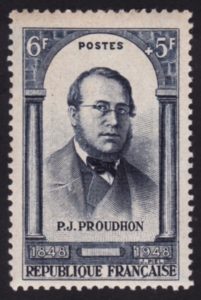 Franse Revolutie
Franse Revolutie
In Frankrijk zijn nooit postzegels verschenen met de Commune als onderwerp. Dit is een gevolg van de ambivalente houding die de Franse staat altijd inneemt ten opzichte van haar verleden. Aan de ene kant probeert zij haar glorieuze verleden – als staat – met prominente staatslieden en belangrijke momenten uit haar geschiedenis in stand te houden, aan de andere kant moet Frankrijk als voorvechtster van vrijheid, gelijkheid en broederschap hoog in het vaandel gehouden worden. Een lastige combinatie, zo illustreert de uitgifte van enkele zegels daar.
Aan de Franse Revolutie als gebeurtenis heeft de Franse staat nooit een zegel gewijd, al werden hoofdrolspelers Robespierre en Danton wel eens vereeuwigd. Frankrijk publiceerde zegels met staatslieden als Napoleon I en Napoleon III en veel historische monumenten als de Arc de Triomphe, het Élysée-paleis en het Louvre. Presidenten als Mitterrand, Pompidou en De Gaulle en enkele sociaal-democratische politici als Jean Jaures en Léon Blum zijn voor de eeuwigheid op zegels vastgelegd. Zo ook de conservatieve politicus Adolphe Thiers, de ‘slachter van de Commune’.
In de schemering van deze figuren staan sporadisch afgebeelde socialisten en anarchisten, echter niet in die hoedanigheid. Pierre-Joseph Proudhon (1809-1865), een der grondleggers van de anarchistische theorie, verscheen in 1948 op een zegel. Dit een serie ter herdenking van de revolutie van 1848, met onder anderen portretten van Louis Blanc, Louis-Auguste Blanqui en Armand Barbès. De rol van Proudhon tijdens die revolutie was overigens beperkt.
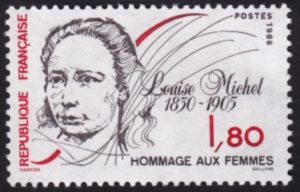 Commune van Parijs
Commune van Parijs
Weliswaar is de bekendste deelnemer aan de Parijse Commune, Louise Michel (1830-1905), de ‘Rode Maagd’, in Frankrijk op een postzegel afgebeeld, maar niet vanwege haar rol tijdens die opstand. Tijdens de Commune vocht ze op de barricades en verzorgde ze gewonde opstandelingen. Later was Michel actief als voorvechtster van vrouwenrechten en organiseerde ze onderwijs voor kinderen uit arme milieus. Het Franse eerbetoon aan haar is nogal beperkt, hoewel veel scholen naar haar vernoemd zijn. In Parijs is geen straat die haar naam draagt, al is er in de Parijse wijk Levallois Perret, niet ver van de begraafplaats waar haar graf te vinden is, een metrostation Louise Michel. Op een postzegel uit 1986 krijgt haar portret het predicaat ‘Hommage aux Femmes’ mee.
Voor een andere deelnemer aan de Commune geldt hetzelfde: Jules Vallès (1832-1885). Namens het 15e Arrondissement werd hij gekozen in de Raad van de Commune. De zegel die in 1982 verscheen met zijn beeltenis, herdenkt alleen zijn 150 e geboortedag en eert hem als schrijver en journalist, niet als betrokkene bij de Commune.
Protestsongs
Anders ging het in Zweden, waar de posterijen in 1980 de syndicalistische vakbondsstrijder, folkzanger en schrijver van tientallen protestsongs, Joe Hill (1879-1915) herdachten. De zegel heeft als toevoeging: ‘We’ll have freedom, love and health, When the grand red flag 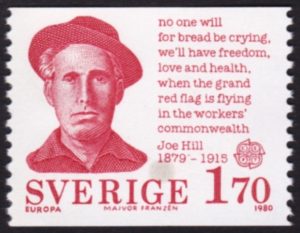 is flying, In the Workers’ Commonwealth.’ De oorspronkelijk in Zweden geboren Hill werd het boegbeeld van de vakbond Industrial Workers of the World (IWW). Met zijn venijnige songs, die opriepen tot een arbeidersrevolutie, was hij een doorn in het oog van mijnbazen en fabriekseigenaren. Toen hij na een roofoverval gearresteerd werd – waarvan nooit duidelijk is geworden of hij die pleegde – leek het een uitgelezen kans de populaire zanger de mond te snoeren. Na een dubieus proces werd hij in 1915 in Utah geëxecuteerd.
is flying, In the Workers’ Commonwealth.’ De oorspronkelijk in Zweden geboren Hill werd het boegbeeld van de vakbond Industrial Workers of the World (IWW). Met zijn venijnige songs, die opriepen tot een arbeidersrevolutie, was hij een doorn in het oog van mijnbazen en fabriekseigenaren. Toen hij na een roofoverval gearresteerd werd – waarvan nooit duidelijk is geworden of hij die pleegde – leek het een uitgelezen kans de populaire zanger de mond te snoeren. Na een dubieus proces werd hij in 1915 in Utah geëxecuteerd.
Verzamelaars
In zijn algemeenheid is de politieke overtuiging van anarchisten vrijwel nooit een reden om hun portret op een zegel te plaatsen, maar spelen andere redenen een rol om naam en persoon te vereeuwigen.
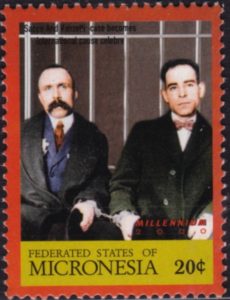 Mexico staat niet bekend als een gedecentraliseerde, optimaal democratische staat. Toch beweert de regering nog steeds te handelen vanuit het gedachtegoed van Emiliano Zapata, de anarchistische boerenleider die tijdens de Mexicaanse Revolutie (1910-1920) streed voor landhervormingen. Het uitbrengen van zegels met Zapata heeft dan ook slechts een propagandistische waarde.
Mexico staat niet bekend als een gedecentraliseerde, optimaal democratische staat. Toch beweert de regering nog steeds te handelen vanuit het gedachtegoed van Emiliano Zapata, de anarchistische boerenleider die tijdens de Mexicaanse Revolutie (1910-1920) streed voor landhervormingen. Het uitbrengen van zegels met Zapata heeft dan ook slechts een propagandistische waarde.
De reden waarom Micronesië, een eilandenstaat in de Stille Zuidzee, Sacco en Vanzetti – twee onschuldig in de Verenigde Staten in 1927 ter dood veroordeelde Italiaanse anarchisten – op een zegel plaatste, blijft echter nogal duister. Want zelfs voor verzamelaars is de waarde van dit soort zegels vrijwel nihil.
Van Bach tot Glass: Paul Simon en serieuze muziek
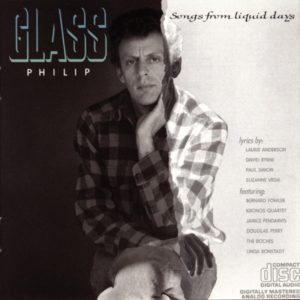 Op een aantal punten speelt klassieke muziek, althans serieuze muziek, een rol in het werk van Paul Simon. Veel Simon-fans zal het nummer American Tune op het album There goes Rhymin’ Simon (1973) bekend in de oren hebben geklonken. De echte kenners onder hen konden de melodie thuisbrengen als een deel uit de Mattheus Passie van Johan Sebastian Bach, en wel uit het choraal O, Haupt vol Blut und Wunden. Dat was op zich door Bach zelf weer geleend van Mein G’müt ist mir verwirret, een seculier, d.w.z. niet-kerkelijk, werk van Hans Leo Hassler von Roseneck (1564-1612).
Op een aantal punten speelt klassieke muziek, althans serieuze muziek, een rol in het werk van Paul Simon. Veel Simon-fans zal het nummer American Tune op het album There goes Rhymin’ Simon (1973) bekend in de oren hebben geklonken. De echte kenners onder hen konden de melodie thuisbrengen als een deel uit de Mattheus Passie van Johan Sebastian Bach, en wel uit het choraal O, Haupt vol Blut und Wunden. Dat was op zich door Bach zelf weer geleend van Mein G’müt ist mir verwirret, een seculier, d.w.z. niet-kerkelijk, werk van Hans Leo Hassler von Roseneck (1564-1612).
Over Bach als inspiratiebron heeft Simon zich, voor zover mij bekend, nooit uitgelaten.
In 1971 leverde Simon een tekst voor een compositie van Leonard Bernstein, vooral bekend van the West Side Story. Mass. A Theatre Piece for Singers, Players and Dancers is wat wij in revolutionairder tijden een beatmis noemden. Een opmerkelijk werk, deze katholieke mis door deze joodse componist.
Simons volledige bijdrage bestaat uit vier regels:
Half of the people are stoned
And the other half are waiting for the next election.
Half the people are drowned
And the other half are swimming in the wrong direction.
Bernstein bedankt hem met deze voetnoot:
This quatrain was a Christmas present from Paul Simon. Gratias. L.B.
(Dit kwatrijn was een Kerstgeschenk van Paul Simon. Merci. L.B.)
Changing opinion
Gradually we became aware of a hum in the room
An electrical hum in the room
It went mmmmmm
We followed it from corner to corner
We pressed out ears against the walls
We crossed diagonals and put our hands on the floor
It went mmmmmm
Sometimes it was a murmur
Sometimes it was a pulse
Sometimes it seemed to disappear
But then with a quarter-turn of the head
It would roll around the sofa
A nimbus humming cloud
Mmmmmm
Maybe it’s the hum of a calm refrigerator
Cooling on a big night
Maybe it’s the hum of our parents’ voices
Long ago in a soft light
Mmmmmm
Maybe it’s the hum of changing opinion
Or a foreign language in prayer
Maybe it’s the mantra of the walls and wiring
Deep breathing in soft air
Mmmmmm
Paul Simon, toch al niet bekend om de toegankelijkheid van zijn teksten, bereikte hiermee een nieuw hoogtepunt in diepgang.
De gezamenlijk inspanningen mondden uit in de cd Songs from Liquid Days (1986), zo genoemd naar de bijdrage van David Byrne. Glass had in 1983 al meegewerkt aan het Paul Simon album Hearts and bones. Hij schreef de coda (het afsluitend deel van een muziekstuk) waarmee de plaat eindigt.
Dat was overigens nog niet het einde van hun collaboratie. Op 23 mei 2007 werd aan Paul Simon de eerste Gershwin Prize for Popular Song uitgereikt. Tot de gastoptredens – van James Taylor en Miriam Makeba tot Art Garfunkel en Stevie Wonder – hoorde ook dat van Glass, die een solopiano versie van Sound of silence speelde.
En aan het booklet bij de 3cd-box Paul Simon 1964 – 1993 droeg Glass het essay Graceland and beyond bij. Daarin plaatst hij Simon, wellicht tot diens eigen verbazing, op één lijn met de belangrijkste Amerikaanse deuntjesmakers:
“For me, Paul Simon is, simply, one of the leading songwriters of modern times, responsible for more ‘standards’ than any other single songwriter of his generation. You have to go back to composers like Porter, Gershwin and Berlin to find comparable talent.”
(Voor mij is Paul Simon eenvoudigweg een van de meest vooraanstaande songwriters van de moderne tijd, verantwoordelijk voor meer ‘standards’ dan enige andere tekstschrijver-en-componist van zijn generatie. Je moet teruggaan tot componisten als Porter, Gershwin en Berlin om vergelijkbaar talent te vinden.)
Op de een of andere manier doet een vergelijking met Cole Porters Night and day, George Gershwins I got rhythm en Irving Berlins White Christmas, om maar een paar ‘standards’ te noemen, met Bridge over troubled water, The boxer en Duncan me sterk denken aan appels en peren.
—
Robert-Henk Zuidinga (1949) studeerde Nederlandse en Engelse Moderne Letterkunde aan de Universiteit van Amsterdam. Hij schrijft over literatuur, taal- en bij uitzondering – over film.
De drie delen Dit staat er bevatten de, volgens zijn eigen omschrijving, journalistieke nalatenschap van Zuidinga. De boeken zijn in eigen beheer uitgegeven. Belangstelling? Stuur een berichtje naar: info@rozenbergquarterly.com– wij sturen uw bericht door naar de auteur.
Dit staat er 1. Columns over taal en literatuur. Haarlem 2016. ISBN 9789492563040
Dit staat er II, Artikelen en interviews over literatuur. Haarlem 2017. ISBN 9789492563248
Dit staat er III. Bijnamen en Nederlied. Buitenlied en film, Haarlem 2019. ISBN 97894925636637
Gotham: bijnamen van New York
Sinds de terroristische aanvallen op het World Trade Center op 9 september 2001 is Ground Zero, meteen na Twin Towers, de meest gehoorde bijnaam in verband met New York. Ground Zero is van oorsprong een militaire term voor het centrum van een kernbomexplosie, ook hypocentrum geheten. De vergelijking met het desolate gebied rond het WTC ligt voor de hand. Toch werd het begrip ook al voor die tijd gebruikt: in 1997, bijvoorbeeld, verscheen het boek New Life at Ground Zero, over het herstel van achterstandswijken in New York in de jaren 80 en 90.
New York is een stad van veel bijnamen. The Big Apple is de bekendste, maar bij lange niet de oudste. Dat is Manhatta, de naam die de oorspronkelijke bewoners, de Algonkin Indianen, gaven aan het eiland dat later Manhattan ging heten. Het betekent ‘slanke vorm’. Ook de tweede naam van dat langwerpige eiland, Nieuw Amsterdam, kan als bijnaam gezien worden.
De aardigste naam voor New York is Gotham, geïntroduceerd door Washington Irving (1783- 1859) in zijn boek Salmagundi (1807). Gotham, een verbastering van Goats’ Town, is een Engels dorp onder Nottingham, waarvan de inwoners in de middeleeuwen de reputatie hadden zich gekker voor te doen dan ze waren. Veel van hun vrolijke verhalen werden geboekstaafd in de Merie Tales of the mad men of Gotam (1565). De sluwheid van de Gothammers sprak de bewoners van Manhattan voldoende aan om hun eigen stek naar dat Britse dorp te noemen.
Het Amerikaanse Gotham kreeg wereldwijde bekendheid als woonplaats van de stripfiguur Batman. Ook voor de thuishaven van een andere stripheld, het Metropolis van Superman, heeft New York model gestaan. Een lijvige geschiedenis van New York – 1.383 pagina’s – kreeg in 1999 de simpele titel Gotham.
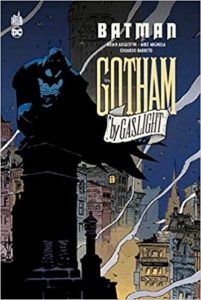 Over de oorsprong van the Big Apple bestaan verscheidene theorieën. De meest geaccepteerde is, dat het in de jaren 30 van de 19-de eeuw de naam van een nachtclub in Harlem was. Daar optreden was toen voor jazzmusici het hoogst bereikbare en gaandeweg werd onder jazzmusici naar New York verwezen als the Big Apple. In de jaren 70 werd het de officiële roepnaam, toen een promotiecampagne voor de stad op die naam gebaseerd werd.
Over de oorsprong van the Big Apple bestaan verscheidene theorieën. De meest geaccepteerde is, dat het in de jaren 30 van de 19-de eeuw de naam van een nachtclub in Harlem was. Daar optreden was toen voor jazzmusici het hoogst bereikbare en gaandeweg werd onder jazzmusici naar New York verwezen als the Big Apple. In de jaren 70 werd het de officiële roepnaam, toen een promotiecampagne voor de stad op die naam gebaseerd werd.
Big Apple bleek een productieve bijnaam: Jaffa, bekend om zijn sinaasappelen, heet in Israël the Big Orange en in de Disneytekenfilm Hercules (1997) vertrekt de hoofdpersoon naar Babylon, ofwel the Big Olive.
Dankzij Frank Sinatra en Lee Towers kreeg een regel uit de titelsong van de film New York, New York (1977) een eigen leven: the city that never sleeps. In een met de strijd tussen Amsterdam en Rotterdam vergelijkbare concurrentie afficheert Chicago zich, niet zonder sarcasme, als the city that works.
De Twin Towers zijn niet de enige gebouwen in New York die een bijnaam aan hun vorm ontlenen. Het ovale gebouw op de hoek van de 53-ste straat en Third Avenue heet niet voor niets the Lipstick Building, en de eerste wolkenkrabber op Manhattan, op het hoekpunt van Broadway en Fifth Avenue, dankt aan zijn driehoekige basis de naam the Flatiron: het
strijkijzer.
Maar bijnamen komen niet alleen voort uit een vorm. De Dakota, het appartementengebouw aan de westkant van Central Park, stond, toen het tussen 1880 en 1884 gebouwd werd, zó ver buiten de bewoonde wereld dat New Yorkers het gevoel hadden dat het in de staat Dakota, in het midwesten van Ameria, gesitueerd leek. Het prachtige Woolworth Building, kantoorkolos van de Woolworth-keten (een soort Hema), kreeg het etiket the Cathedral of Commerce.
Aan de oostkant van het park ligt the Museum Mile, het stuk Fifth Ave. met enkele van New Yorks belangrijkste musea: het Metropolitan, het Guggenheim en the Frick Collection. Aan dat deel van 5th Ave. huisden families als de Vanderbilts, de Astors en de Rockefellers.
Logisch dat dat stukje Millionaires’ Row genoemd werd. Het op deze hoogte gelegen deel van de Upper East Side is het Silk Stocking District. Het gedeelte ten oosten van de zijden kousen-wijk heet – met een verwijzing naar de roman van John Steinbeck – East of Eden, dat wil zeggen: buiten het paradijs.
De hel ligt tegenwoordig een stuk zuidelijker. Maar Ground zero wordt eveneens gebruikt in de betekenis van punt om iets weer van de grond af aan op te bouwen.
New York heeft, als een Nieuw Rotterdam, de mouwen opgestroopt.
Eerder gepubliceerd: Bijgenaamd, Achterpagina NRC-Handelsblad, 17 oktober 2001.
Robert-Henk Zuidinga (1949) studeerde Nederlandse en Engelse Moderne Letterkunde aan de Universiteit van Amsterdam. Hij schrijft over literatuur, taal- en bij uitzondering – over film.
De drie delen Dit staat er bevatten de, volgens zijn eigen omschrijving, journalistieke nalatenschap van Zuidinga. De boeken zijn in eigen beheer uitgegeven. Belangstelling? Stuur een berichtje naar: info@rozenbergquarterly.com– wij sturen uw bericht door naar de auteur.
Dit staat er 1. Columns over taal en literatuur. Haarlem 2016. ISBN 9789492563040
Dit staat er II, Artikelen en interviews over literatuur. Haarlem 2017. ISBN 9789492563248
Dit staat er III. Bijnamen en Nederlied. Buitenlied en film, Haarlem 2019. ISBN 97894925636637
Noam Chomsky: Amid Protests And Pandemic, Trump’s Priority Is Protecting Profits
Many years ago, social scientist Bertram Gross saw “friendly fascism” — an insidious authoritarianism that denies democratic rights for corporate ends without the overt appearance of dictatorship — as a possible political future of the United States.
Today, that future has arrived. Donald Trump has not only consolidated the integration between Big Business and government, but now, with the country in the grip of some of the biggest protests in more than half a century, he is actually trying to turn the U.S. into a police state, to “‘dominate’ by violence and terrify any potential opposition,” as Noam Chomsky astutely points out in a new and exclusive interview for Truthout.
C.J. Polychroniou: Noam, for the past 40 or so years, we have been witnessing in the U.S. the demolition of the welfare state and the supremacy of the ideology of market fundamentalism to the point that the country is unable to deal with a major health crisis, let alone resolve long-standing issues like large-scale poverty, immense economic inequalities, racism and police brutality. Yet, Donald Trump did not hesitate in the midst of the George Floyd protests to declare that, “America is the greatest country in the world,” while he is seeking at one and the same time to start a new civil war in this country through tactics of extreme polarization. Can you comment on the above observations?
Noam Chomsky: I don’t think Trump wants a civil war. Rather, as he says, he wants to “dominate” by violence and terrify any potential opposition. That is his standard reflex. Just look at his outburst when one Republican Senator, Lisa Murkowski, broke strict Party discipline and raised some mild doubts about the magnificence of His Royal Majesty. Or his firing of the scientist in charge of vaccine development when he raised a question about one of Trump’s quack medicines. Or his purge of the inspector generals who might investigate the fetid swamp he’s constructed in Washington.
It’s routine. He’s a radically new phenomenon in American political history.
Another Trump reflex is his call for “the most vicious dogs, and most ominous weapons, I have ever seen” when peaceful protesters appear near his abode. The phrase “vicious dogs” evokes the country’s horror when images of vicious dogs attacking Black demonstrators appeared on the front pages during the civil rights movement. Trump’s use of the phrase was either by intent, to stir up racist violence, or reflexive, arising from his innermost sentiments. I leave it to others to judge which is worse, and what either tells us about the malignancy at the center of global power.
With that qualification, there is no inconsistency. Both the claim that America is the greatest country in the world, in his special sense, and his call for domination, follow from his guiding doctrine: ME!
A direct corollary to the doctrine is that he must satisfy the demands of extreme wealth and corporate power, which tolerate his antics only insofar as he serves their interests abjectly, as he does with admirable consistency in his legislative programs and executive decisions, such as the recent Environmental Protection Agency decision to increase air pollution “in the midst of an unprecedented respiratory pandemic,” risking tens of thousands of deaths, disproportionately Black, the business press reports, but increasing wealth for those who matter.
The success of his tactics was revealed clearly at the January extravaganza at the Davos ski resort, where the masters of the universe, as they are called, meet annually to cavort and congratulate one another. This year’s meeting departed from the norm. There was visible concern about “reputational risk” — recognition that the peasants are coming with their pitchforks. Therefore, there were solemn declarations that, We realize we’ve made mistakes, but we are changing, you can put your faith in us, we will become “soulful corporations,” to borrow the phrase used in accolades to corporate America in the ‘50s.
